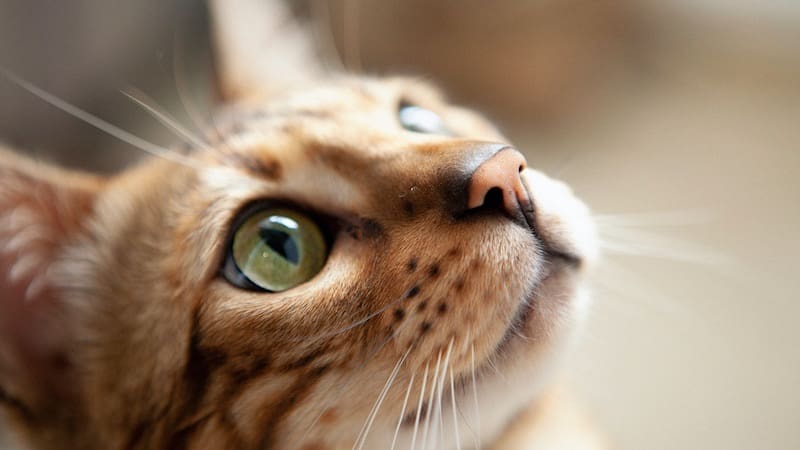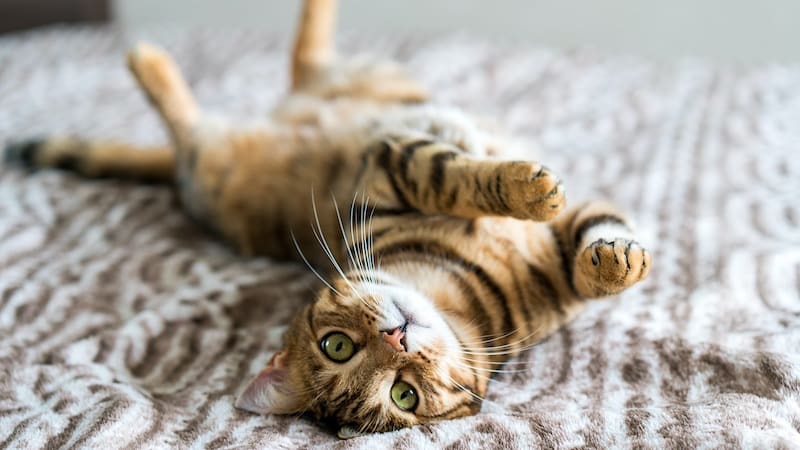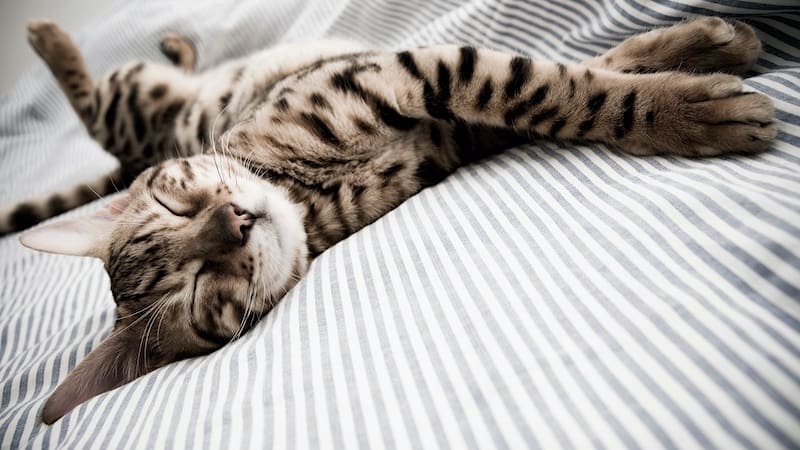If you’re considering getting a cat but suffer from allergies, this is an important question to ask. While there are no fully hypoallergenic breeds, the Bengal cat breed may be one of the better choices for an allergy sufferer than other felines.
Are bengal cats hypoallergenic? Bengal cats are generally considered to be hypoallergenic, meaning they are less likely to cause an allergic reaction in people with cat allergies. However, it’s important to note that no cat breed is completely allergy-free, and some people with severe allergies may still have a reaction to a Bengal cat.
Before making your decision on which indoor cat to adopt, it’s best to understand what causes cat allergies and how they can affect people differently. Here I’ll explore whether or not Bengals are actually hypoallergenic as well as some tips on reducing reactions when caring for a feline companion with sensitivities in mind.
What is a Bengal Cat?

The Bengal is a hybrid breed of domestic cat that originated in the United States. It was created in the 1980’s by crossing an Asian Leopard Cat with a domestic cat, and its distinctive markings are similar to those of its wild ancestor.
Since then, Bengals have become increasingly popular as pets due to their beautiful coats and friendly personalities.
Physical Characteristics:
Bengals are medium-sized cats that typically weigh between 8-15 pounds at maturity, although some may be larger or smaller depending on genetics and diet. They usually have short fur which can range from golden brown to black in coloration, often featuring spots or stripes reminiscent of their ALC ancestors’ markings.
Their eyes are large and almond shaped, ranging from greenish yellow to gold or copper colors depending on coat coloration.
Despite being descended from wild animals, Bengals tend to be very affectionate towards humans if given proper socialization training as kittens or young adults. The Bengal cat loves playing games such as fetching toys like other domesticated breeds do and are known for being quite active compared to other indoor cats; many owners report having difficulty keeping up with them during playtime.
Bengal cats are a unique breed that have been bred to look like wild cats while still being domesticated. They possess many physical and temperamental characteristics that make them an attractive choice for indoor cat owners, but their hypoallergenic status is still up for debate. Let’s explore the answer to this question in the next heading.
Recap: Bengal cats are a hybrid breed of domestic cat that originated in the United States. They have short fur and can range from golden brown to black in coloration, often featuring spots or stripes reminiscent of their ALC ancestors’ markings. They are known for being very affectionate towards humans and quite active during playtime.
Are bengal cats hypoallergenic?

Hypoallergenic cat breeds are those that produce fewer allergens than other types of cat. The Bengal cat is one such breed; it produces lower levels of Fel D1 protein (the main allergen produced by cats) compared to other breeds of cats.
Bengal cats are a unique breed that have the potential to be hypoallergenic. However, there are still steps that allergy sufferers must take in order to reduce their allergic reactions.
Allergens Produced by Cats:
All cats produce allergens, which are proteins that can cause an allergic reaction in people. These allergens are found in cat saliva, urine, and dander (dead skin cells). When a cat licks itself or sheds its fur, these proteins become airborne and can be inhaled by humans.
Low Shedding Breeds:
Some types of cat shed less than others due to their fur type or length. Low shedders include the Devon Rex, Sphynx, Cornish Rex, Russian Blue, Oriental Shorthair and Balinese. These cats have short coats that don’t require much grooming or brushing so they tend to shed less than other breeds of cats.
How to Reduce Allergy Symptoms
Although Bengal cats bengal cats are hypoallergenic some people may still get allergy symptoms. If you are an allergy sufferer and have symptoms such as skin irritation, a runny nose, inflamed eyes, sneezing etc. when around a cat there a few things you can do to lesson the symptoms.
Medicate yourself with antihistamine tablets
Keep the litter box clean
Vacuum daily
Grooming Tips for Allergy Sufferers:
Grooming your cat regularly is one of the best ways to reduce allergic reactions. Regular brushing and combing will help remove excess fur, dander, and allergens from your cat’s coat.
Additionally, regular baths can help keep allergens at bay. Make sure to use a hypoallergenic shampoo that won’t irritate your cat’s skin or cause an allergic reaction in you or other family members.
Cleaning Tips for Allergy Sufferers:
Cleaning up after your pet is essential when it comes to reducing allergies caused by cats. Vacuuming carpets and furniture on a regular basis will help remove any dander or fur that may be present in the home environment.
It’s also important to wash bedding frequently with hot water as this helps kill dust mites which are also known triggers of allergies in humans and animals alike. Additionally, using a Hepa air filtration system throughout the house can also help reduce airborne allergens such as pollen, mold spores, and pet dander that may trigger an allergic reaction in some people.
By following the tips and advice in this article, you can take steps to reduce your reactions to your furry friend.
Recap: Regular grooming and cleaning are key to reducing allergies caused by cats. Allergy sufferers should brush, comb, bathe their cat with hypoallergenic shampoo and vacuum carpets and furniture regularly as well as wash bedding in hot water and use air purifiers.
Caring for a Bengal with Cat Allergies
Occasionally its your indoor cat that is suffering from an allergy. When caring for a Bengal with a cat allergy it is important to be aware of potential triggers in the home environment and know how to manage symptoms.
Avoiding Triggers in the Home Environment
This can include dust mites, pollen, pet dander, mold spores, and other allergens that may be present indoors. To reduce exposure to these, it’s important to vacuum regularly and use air purifiers or HEPA filters.
Bengals are also known to be prone to be allergic to certain cat foods so you might want to try a cat food rich in Omega-3 fatty acids.
A flea allergy is not uncommon in cats either so a flea collar is always advised.
It’s also helpful to keep windows closed during high-pollen times of year and avoid smoking inside your home. Additionally, washing bedding frequently can help reduce allergen levels as well as using special hypoallergenic litter boxes if needed.
Though caring for a Bengal cat with an allergy can be challenging, the rewards of having one as a companion are worth it. In conclusion, it is important to understand the benefits and considerations before adopting a Bengal cat.
Recap: To reduce exposure to allergens in the home environment and manage symptoms of allergies in cats, it’s important to vacuum regularly, use air purifiers or HEPA filters, keep windows closed during high-pollen times of year, avoid smoking inside your home, wash bedding frequently and feed them a diet rich in omega-3 fatty acids.
Benefits of Owning a Bengal Cat

Bengals are active cats who love to explore their home. This makes them ideal companions for people who enjoy playing with their pets or going on adventures together.
Additionally, they tend to be very social animals who bond closely with their owners and other family members. They can also be trained to do tricks or use the litter box reliably if given enough time and patience from their owners.
Lastly, Bengals have low-shedding coats which make them hypoallergenic compared to many other cat types; this makes them perfect for people suffering from an allergy or asthma who still want the companionship of a pet in their home without having a reaction every day.
Recap: Bengal cats are an ideal choice for people who want a companion pet but suffer from allergies or asthma. They are active, social animals with low-shedding coats which makes them hypoallergenic. Benefits include: bonding closely with their owners, being able to be trained, and not triggering allergic reactions.
FAQs in Relation to Are Bengal Cats Hypoallergenic?
What is the best cat for someone with allergies?
If you have cat allergies the best type is a hypoallergenic breed, such as the Siberian or Balinese. These cats produce fewer allergens than other breeds and are generally considered to be the most suitable choice for those with allergies.
It’s important to note that even hypoallergenic cats can still cause allergic reactions in some people, so it’s always wise to spend time around any potential pet before making a commitment. Additionally, regular grooming and frequent vacuuming of your home can help reduce allergen levels significantly.
Is a Bengal cat allergy free?
No, Bengal cats are not allergy free. They can cause allergic reactions in some people due to their thick coats and dander. Allergies to cats can vary from person to person, but it is possible for someone with a cat allergy to have an allergic reaction when around a Bengal cat.
If you or someone in your household has allergies, it’s best to consult with an allergist before bringing any pet into the home.
Are Bengal cats low shedding?
Bengal cats are known for their low shedding coats. Their short, dense fur is designed to keep them warm in cold climates and sheds very little compared to other breeds of cats.
Bengals also have a unique spotted pattern that adds to their beauty. Grooming these cats regularly can help reduce the amount of hair they shed even further. Bengals are also known for their intelligence and active personalities, making them great companions.
Is there a 100% hypoallergenic cat?
No, there are no 100% hypoallergenic cats. All cats produce some level of allergens, which can cause reactions in people who are allergic to cats. The amount of allergen produced by each individual cat varies greatly depending on the breed and other factors.
Some breeds may be less likely to trigger an allergic reaction than others, but even these cats will still produce some allergens. If you have allergies, it’s best to consult with your doctor before getting any pet.
Are Bengal cats expensive?
The Bengal is a stunningly beautiful animal, sheds little and if looked after, are affectionate to their owners. These traits make it an in demand pet so you should expect to pay between $1500 and $3,500 for a Bengal kitten.

Conclusion
In conclusion, the answer to the question “Are Bengal cats hypoallergenic?” is not a simple yes or no. While there is no such thing as a true hypoallergenic cat, Bengals may be less likely to cause an allergic reaction in some people due to their low shedding coats.
However, it’s important for allergy sufferers to take into account other factors that can contribute to allergies when considering bringing any pet into their home.
If you are looking for a pet and have allergies, make sure you do your research and consult with your doctor before making any decisions.





